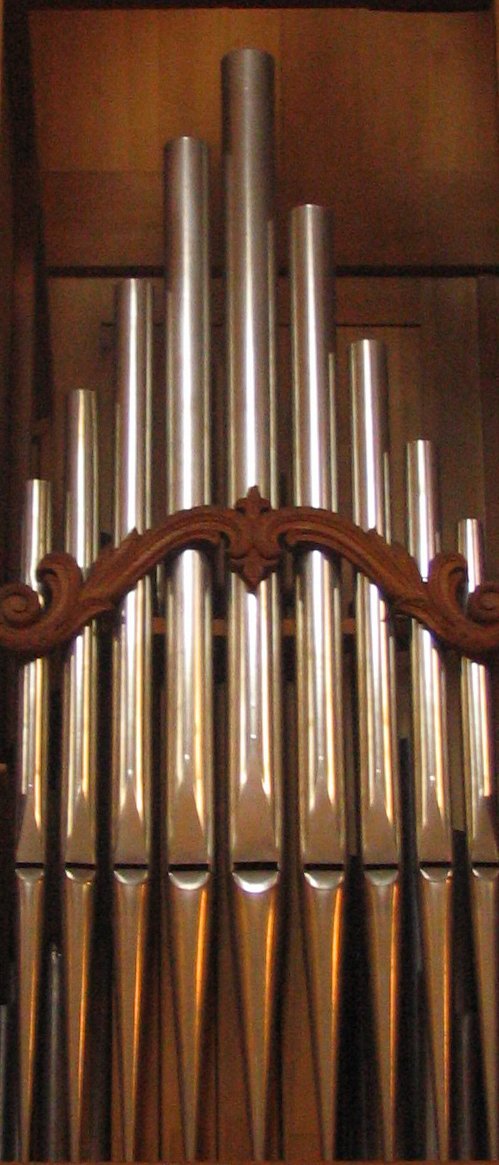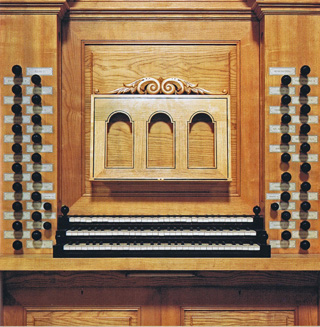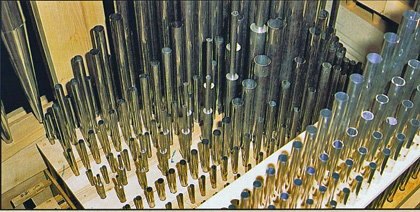

Organ : 3 keyboards , pedalboard - 35 stops

For the Cathedral of Fréjus, the project to build a new instrument referring largely to the Italian style, was motivated by the will to reconnect with a regional tradition of this part of the southeast of France which received for a long time the influence of Italy regarding the organ building.
That is why the general form of the case with its decoration compound of sculptures and trompe l'oeil marquetries is freely inspired from Italian organs of the 17th, 18th centuries.


The instrumental part, was also thought around a "ripieno" of the main keyboard.
This one integrates the third division, by alternated engravings, in addition to the first one.
In the base, on both sides of the keyboard's window, is the Positive rather in compliance with an organization, this time, of French type of the 18th century. Nevertheless, the harmonization does not refer to the technical criteria of the Italian organ building and it is especially the clearness and the transparency of the sound, the sound characteristics which we appreciate so much in the Italian organ, which were searched here.
Composition :
| Positif - 56 notes | Grand-Orgue - 56 notes | Récit - 56 notes | Pédale - 30 notes |
| Bourdon 8' | Principal 16' | Principal 8' | Bourdon 16' en bois |
| Octave 4' | Principal 8' | Flûte 4' | Flûte 8' en bois |
| Quinzième 2' | Bourdon 8' | Flûte conique 2' | Flûte conique 4' |
| Plein-jeu 5 rangs | Octave 4' | Flûte 1' | Basson 16' |
| Flûte 4' | Douzième 2 2/3' | Sesquialtera (1 1/3 et 4/5 au do1 2 2/3 et 1 3/5 au do2) |
Trompette 8' |
| Nazard 2 2/3' | Quinzième 2' | Voce humana 8' | Clairon 4' |
| Flûte 2' | Dix-neuvième 1 1/3' | Voix humaine 8' | |
| Tierce 1 3/5' | Vingt-deuxième 1 | ||
| Cromorne 8' | Ripieno 1 (2/3 et 1/2) | ||
| Ripieno 2 (1/3 et 1/4) | |||
| Cornet 5 rangs | |||
| Trompette 8' | |||
| Clairon 4' |
Shift couplers pos/G.O. - Solo/G.O. - Tremulant


The construction of this instrument, finished in 1991, was also realized with the cooperation of the organ builder Jean Louis Loriaut.
The musical illustration for this instrument presents pieces played by Viviane Loriaut and Francis Chapelet. They emphasize the clearness very increased of the "plenum" and the numerous possible colors allowed by the separated rows of the ripieno.
Cabanilles, Bruna, Soler -Viviane Loriaut
Scheidt, Buxtehude -Francis Chapelet